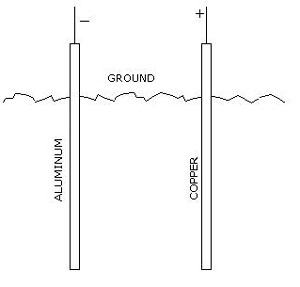 |
Their dissimilar metal electrodes in
contact with an electrical conducting electrolyte will always produce a voltage.
However, the electrolytes in the ground are weak, so the power produced by those
batteries is quite low. Also, the metal surface area in contact with the soil is
small. It would take rather large metal plates to yield meaningful power.
Wily wondered just how much power these
earth batteries could produce. Willy went to his junk pile and grabbed an aluminum
pipe and a copper pipe, both about ¾ of an inch in diameter. He took them into
his back yard and pounded them into the grass. He only pushed them into the soil
about 6 inches, so he could easily remove them. He then measured the open
voltage. It was about 1.0v. He then measured the short circuit current.
It measured 1ma. Wily knew that by pushing the two metal pieces deeper into the
soil it would most likely not increase the voltage but would increase the current, by
bringing more metal in contact with the soil. He figured |
|
that if he could sharpen the two pipes
and pound them all the way down to 6 feet, the available current might increase to
12ma. But, if the current increase is proportional to the surface area, then he
could also increase the current by using large metal plates instead of pipe. Two
plates, one of copper and one of aluminum, buried in the ground. would certainly have
a larger contact area than pipes. A ¾ inch pipe 6 inches long has a surface area
of only 14 square inches and generated about 1ma of current. This yields a 0.07ma per
square inch current factor. If Wily used two large metal plates 24 inches by 24
inches, with both sides in contact with the soil, he would have a battery with 1152
square inches and should produce about 82ma of current. Figuring the source
impedance of such a power source is V/I or 12 ohms, then maximum power transfer would
occur when the load was also 12 ohms. So, if Wily buried two large plates of
metal in the ground and put a 12 ohm load across them, the voltage would drop from
1.0v to 0.5v and the current would be 41ma. This would yield a power of 20mw.
That is not much power. In comparison, Wily knew that a quality single solar
cell measuring just one square inch would produce about 100mw of power, which is 5
times more than the large earth battery. So, those earth batteries are just not
very useful for anything other than the novelty of producing some electricity out of
the earth. |